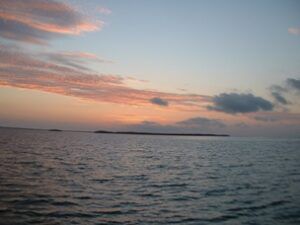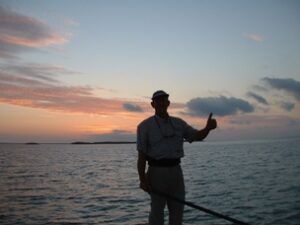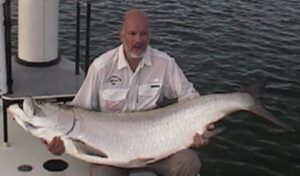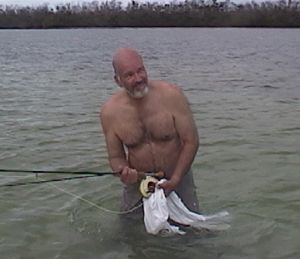It is late May in Key West. Royal Poinciana blossoms siren the spawning season for Tarpon, aka “silver king”, in Florida Keys waters. Tarpon season is here and schools of megalops atlanticus are now migrating across shallow near shore waters luring anxious anglers from distant lands to Cayo Hueso (a.k.a. Key West), the southernmost point of the continental USA. The spawning Tarpon range in size from fifty to over 200 pounds. Large schools, some with as many as 200-300, are encountered in mid to late May each season. This is the true story of one unforgettable angling adventure fighting the mighty “silver king” Tarpon.
I am guiding two experienced Tarpon anglers and our destination is the Atlantic Ocean atoll known as the Marquesas, 23 miles west of Key West. A 03:30 wake-up call is required. We have to get there at first light when the fish are happy, rolling on the surface, daisy chaining, and laid up in the morning mist. We will run in the dark to get to the right spot on time, around 06:00. Other guided skiffs will undoubtedly make the same journey this morning, so we must get an early start if we want to fish the preferred flat. Being at the right location at the right time according to weather conditions and tidal fluctuations is crucial in order to maximize our chances for success during Tarpon season.
Greg and George know the drill, they are on time at the dock and they waste no time stowing their rods and lunches for the run. “FlatsMaster” is idling out of Garrison Bight by 0510 amid some humorous stories about the “Duval Crawl” live entertainment on the after-hour streets of Key West. One such story involves a race between stripper scooter operators past Sloppy Joes Bar with Key West cops chasing on foot. The details are salted away for future reference as we plane away under the Trumbo Point bridge.
There is not much wind today, maybe 10 knots out of the southeast. Tide is coming in, and will be high at 09:20. By my calculations, there will be just enough water to run the short cut route across a few shallow banks, shaving a few precious minutes off of our travel time. We should be there by 05:50 at the latest. Hammer down, pedal to the metal, let’s just get there, beam us out there Scotty!
We pass through Key West Harbor, past the anchored live-aboard sailing vessels, past Sunset Key. The trip across Northwest Channel in the pitch pre-dawn blackness is always a bit eerie. Since day one I have used compass plotting, watermarks, and moonlit landmarks to navigate at night. My heading is due west traveling at 4200 rpm’s or about 33 mph. Times like these require confidence bound by time on the water. It also helps to acquire the reckless abandon for blind sea travel through a gauntlet of natural and man-made obstacles. In other words, you learn to just go for it using your natural god-given instincts.
There are a few channel beacons flashing green or red signaling shallow banks and shoals that are inches deep. These navigational aids provide triangulation assistance for mariners. Having a million candlepower handheld spotlight on board is also useful when you are anticipating marked cuts that have no lights. This is no time to run aground! A GPS is also useful, but not necessary and most experienced flats guides don’t use electronics. We rely on our territorial knowledge of the flats, shoals, channels and basins.
We reach the gates to the Key West Lakes within 10 minutes. It’ll take another 13 or 14 minutes to reach Boca Grande Channel, the last natural boundary between Key West and the Marquesas. The seas are gentle as expected with light winds and virtually no chop. My spotlight illuminates a sign at the lakes marker that reads CONTROLING DEPTHS 3-5 FEET – LOCAL KNOWLEDGE REQUIRED. I keep my eye on the compass heading 272 – due west – as we glide across the lakes passage with ease. Cranked up to 4800 rpm, our speed increases to nearly 38 mph and we are making good time.
The familiar bounce across Boca Grande Channel is backlit by the glow of first light. We make it to Mooney Harbor Channel entrance to the Marquesas with all eyes searching the sea surface for signs of rolling Tarpon. After a few moments observing no Tarpon activity, we all agree that “Elvis has left the building, let’s check out another spot.” We quickly reposition to the southwest corner along the banks that rim the outside edges of the atoll. We glide down to idle near the eastern-most cut that always seems to produce big fish at dawn’s early light. To our starboard stern, the sunrise gradually lights up the eastern sky projecting an aurora of red, orange, gold and yellow.

Flashes of silver and bronze are spotted in the distance. We have found our first Tarpon rolls of the morning. Without any hesitation, I unleash the push pole and climb upon the tower ready for some poon-time action. “There they are gentlemen, about 11 o’clock, 200 feet.” George is first up on the bow. There are at least two, maybe three daisy chains of schooling Tarpon nearby. These are very large daisy chains. I estimate that there are 50 or more Tarpon in each chain. They are circling around and around in their mating dance tempting us to draw near. We take the bait and gradually glide toward the first school under quiet poling power.

“Marquesa Sunrise first.” The fly pattern choice is obvious in the early morning dark waters, “let’s give them something burnt orange and gold that is easy to see.” During the first 15 minutes of fishing George had three Tarpon eat the fly. All three escaped using various Tarpon-Houdini antics. Spectacular jumps throwing hooks, powerful locomotive runs ending in break offs, and lazy eats with no hook up are just a few of the more frequent Tarpon escape maneuvers. Tarpon are referred to as the SILVER KING because they fight with tremendous energy and stamina and put on a jumping show that rivals the Marlin in deep sea waters.

George casts to another school of circling Tarpon in 6 feet of water. It is a perfect cast with the fly landing on the edge of the Tarpon chain. There is a large female Tarpon swimming toward the fly. Her head tips up out of the water, mouth opens and… George is eager to come tight to the huge fish. He makes a long strip, but the fish swims toward the line and the fly is stripped out of her mouth. Eager angler syndrome sets in and George is now fit to be tied. The fish swims away wondering how the heck that meal escaped. Frustrated with all the near-misses, George turns to his buddy Greg, “Your turn!”
I try my best to console George. Usually, Tarpon will turn their head when they eat in an effort to keep the prey inside their mouth. Sometimes, however, you get what I call a “lazy eat”. A “lazy eat” is when the Tarpon is not aggressive, and generally nonchalant about eating the fly. I firmly believe that the Tarpon is pre-occupied with spawning when this happens. Since they are eating machines, their foraging imprint drives them to go through the eating motions in a snacking manner. In some of these situations, the Tarpon will not turn their head after eating, making a weak attempt to feed. They seem to be focused on their spawning activity, and eating a fly is not a priority.
“George if you get another lazy eat like that, then the most effective counter-measure is to wait for the fish to turn. If the fish takes and keeps swimming toward the boat, then set the hook to the left or to the right with the rod hand. Set to the left if the fish is swimming at an angle that is left to right. Set to the right if the swim angle is from right to left. Set either left or right if the fish is swimming directly toward you at twelve o’clock. That rod-hand action will usually drive the hook point into mouth flesh by virtue of the angle of the set. It is important not to be too fast or too slow with the set. Strip with the speed of the swimming motion of the Tarpon and set with that same speed.”
It has taken me many years of Tarpon angling trial and error to adapt to these strategies. Normally, all aggressive eating Tarpon will turn their head and body after the take and the hook finds flesh quickly, requiring a normal strip set. However, in the “lazy eat” case, anglers need to react with a bit more finesse and react to the Tarpon behavior a bit more methodically. “The bottom line is that you need to watch the fish at all times and be ready to react to any behavior.” Local knowledge and experience is crucial to repeated success with Tarpon or any species for that matter. George is always trying to improve his skills on the flats. It is a pleasure to have him as an angler on my skiff.
George cranks up his video camera, “Channel 9 News Reporter George Hodgson on location in the Marquesas.” George is a techno-driven ivy leaguer who loves to record his days aboard “FlatsMaster” on video. He even has the Channel 9 News logo taped to his SVHS circa 1985 camera body. He begins his latest installment with some shots of the atoll and an introduction to the day’s filming by lamenting his disappointing results. I secretly wish that George had had better success. His character and fun-loving attitude toward the fishing and the entire experience on the flats is refreshing and contagious. George and Greg bust each other’s balls constantly while fishing with me, providing all of us with comedic entertainment. Their camaraderie is a product of their friendship of 40+ years with roots as Cornell University room-mates.
Greg Persbacker is now on the bow, but the daisy chains of Tarpon have vanished. Greg is on a serious Tarpon fever roll. He has boated every giant Tarpon (150-170 pounds) that he has hooked during the previous three days and is looking to go 4 for 4. This is a rare feat accomplished by only experienced anglers with a lot of skill. Greg has the skill set and has acquired the experience and local knowledge in many years on the bow of my skiff and others. Twenty minutes of hunting and finally a few Tarpon are spotted rolling and daisy chaining near the far channel in about ten feet of water.
Greg readies his line for the first cast. 100 feet of floating mastery Tarpon taper fly line is stripped into a fly line tamer. Atop the “cage” (a bow angler platform from which Greg stands 5 feet above the water line looking down on the rolling Tarpon) Greg points with his rod tip, “There, about 120 feet now.” Excited to see Greg hook-up again, I am poling my hind-end off approaching the fish with vigor. “Check that leader for wind-knots and check the fly for fouling while we approach”, I caution Greg, “…don’t want to miss a big one.” Greg checks it out and appears to be satisfied.
The Tarpon are now happily rolling at 10 o’clock from the bow, about 50 feet away. “O.K. Greg, cast when ready, and try to land the fly about five feet in front of the lead fish.” There appeared to be about sixty fish in the school, some large females, a few skinny males and a few pups. Greg false cast twice to judge distance and direction and then delivered the Black Death fly directly in front of the path of what seemed to be the largest fish in the school. “Great cast, Greg, now slowly strip it, they are barely swimming toward you, so easy does it.” A split second later, a large flash under the water and Greg was tight to a big Tarpon. The giant fish erupted out of the water in a flash of silver and bronze leaping 6 feet into the golden Marquesa sky.
George is busy reporting the play by play on the Channel 9 News camera, but his camera malfuncitions. I decide to turn my video camera to supplement George, feeling the need to chronicle some of Greg’s great Tarpon angling for the web site. As I focus the camera on Greg, he is busy fighting the surging Tarpon from the cage platform on the bow. He turns to ask George to get some still shots when…OOOPS!….THE ROD SLIPS OUT OF HIS HANDS AND PLUNGES INTO THE WATER! AGHAST WITH SURPRISE, I AIM MY VIDEO CAMERA AT THE ROD THAT IS SINKING AND BEING TOWED AWAY BY THE TARPON!
Now, if you have ever fought Tarpon before, then you know that they are extremely powerful fish. You also know that SHARKS LIKE TO EAT TARPON. So, equipped with that knowledge, I ask you my reader, a simple question. WHAT WOULD YOU HAVE DONE?
Without hesitation, Greg opens the cage gate and jumps into the water after the rod that is now swimming away with the Tarpon! With a leap of faith and desperation, Greg manages to grab the rod and begins to fight the Tarpon again in earnest while in 12 feet of water. Only Greg’s head and the bent rod protrude above the water line as the Tarpon begins to tow him into the channel. The scene sparks visions of whalers being towed by the likes of Moby Dick! Luckily there were no sharks in sight.

“Hey, are you guys going to come and get me or what?” Greg is struggling to stay afloat. Admittedly, we are a bit stunned into taking pictures to chronicle the moment. As we approach with skiff now under idle power, Greg’s head is still above water and the rod is bent over nearly double. Greg is now at least 150 feet away from the skiff and drifting further away each second as the Tarpon tows him into the Marquesa maelstrom. I am a bit concerned because the these waters always host a few Hammerhead Sharks and Bull Sharks as well as some big Black Tip Sharks during this time of year. Greg’s size presents a large silhouette in the water for a large Shark to see and predate. The predator sharks follow the Tarpon into the flats to feed on them. On more than one occasion, I have lost large Tarpon to a larger Shark in the Marquesas. Suddenly, the thought runs through my mind quickly: I am not prepared to lose an angler to one. “Hang in there, I’m coming, we have to get you out of there, there may be a few sharks around!”

I crank the motor over and idle over to the tethered angler who is barely head above water hanging onto the 12 weight fly rod as his only life line. I glance around one more time in search of excess surface activity, e.g. Shark dorsal fins. I see no danger in sight. Less than a minute later we manage to drag Greg over the starboard gunwhale and back into the skiff. Rod still in hand, Greg makes his way back to the cage on the bow and continues his battle with the mighty silver king. What a fish, what a fight! A half-dozen more spectacular leaps and the fish was still connected. Greg really knows how to play the big fish, bowing at precisely the right moment during each jump.
A few years earlier, Greg battled a huge Tarpon that we estimated to be around 150 pounds or more. The battle took place on the edge of Northwest Channel near Key West’s Pearl Basin. He fought that fish for nearly two hours before breaking it off next to the boat. That battle taught Greg to apply greater pressure early in the fight to defeat the Tarpon’s will to win and thereby shorten the battle. The longer the big fish swims during the fight, the greater the strain on the leader and tippet. A Tarpon’s mouth is like sandpaper, and given enough time it can abrade and break off the best 80 pound shock tippet.
Soaked from head to toe after his swim for his giant Tarpon, but still relatively unfazed, Greg continues to play the “poon” with strength and confidence. When the Tarpon heads for shallow waters, Greg applies the necessary pressure to slow the big fish down. Every so often a “down and dirty” technique is used to rob the Tarpon of a breath of air. Tarpon often will roll on the surface during the fight as they become fatigued. Tarpon must inhale air to sustain respiration and maintain their stamina, as their gills are inefficient oxygenating organs. Each time the Tarpon began to roll, Greg angles his rod low to the water in the opposite direction of the Tarpon’s path, applying extra force to try to turn the fish over during the roll. Greg’s use of this technique frustrates the already fatiguing Tarpon and shortens the fight considerably.
As we approach 45 minutes into the battle, Greg plays the giant fish to within 10 feet of the skiff in a couple of feet of water. The Tarpon still has a bit of fight left, but struggles to pull away. Greg begins to taste victory and with a lurch of the rod handle he tries to lift the Tarpon closer. “Bam”! The rod explodes at the first ferrule. George lets out a groan, “Thanks, good buddy, you just broke my favorite rod!” Luckily we are in shallow water with no sign of sharks about. Greg hesitates for a moment thinking he had blown it, then decides to hand line the fish to the skiff. Out of the cage comes Greg again, and into the shallow water to be one with his fish again.
The 140-160 pound Tarpon is gradually wrestled by the 220 pound angler by hand lining the last twenty feet of fly line to the port gunwale of “FlatsMaster”. Greg cradles the spent Tarpon, kissing the giant fish on its nose. We all marvel at the impressive catch. The giant Silver King was gradually revived and released in good health.

Meanwhile, George is still reporting for his fictional Channel 9 News, “Despite the Marquesa sleigh ride and breaking his best friend’s favorite fly rod, Greg Persbacker has still landed the giant Tarpon! Well done, but you owe me a new rod, big guy!” After his desperate plunge into the shark infested waters and our ensuing rescue of the struggling angler, Greg has learned HOW TO SWIM FOR THE TARPON AND STAY ALIVE! As he washes the Tarpon slime off of his shirt Greg grins ear to ear, laughs heartily and says “Four for four! Four days fly fishing for Tarpon and four days without losing one. Awesome!”

